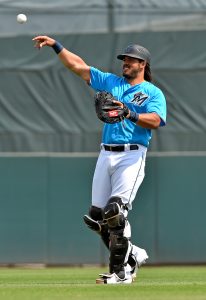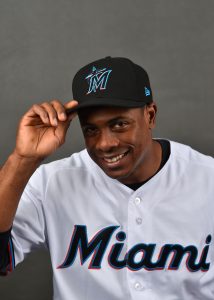By this point, the narrative on Dallas Keuchel is familiar to all: he’s a former Cy Young winner who recently turned 31. He wasn’t at his best last year, but was one of only 13 pitchers to top 200 frames in 2018 and turned in a productive 3.74 ERA. Statcast felt he was actually a bit unlucky, crediting him with a .290 xwOBA-against that lagged the observed .306 wOBA-against.
Keuchel has always thrived on grounders, weak contact, and low walk rates, with middling velocity and generally unexceptional swinging-strike capabilities. At times in the past, Keuchel has been a true groundball monster (he was at a good but not great 53.7% last year) and has generated more strikeouts (up to 23.7% in 2015). While the theory has been proffered recently that Keuchel’s lack of velo is a major factor, it actually seems mostly encouraging that he throws just as hard as ever and that his velocity trended up over the course of the 2018 season. It seems fair to say he’s mostly the same type of pitcher, but not the best version of himself — as you’d probably expect at this age.
We knew all that entering the offseason, of course. It was never questioned that he’d turn down the qualifying offer and not be all that bothered by the draft compensation requirements that attached to his free agency. So how do we explain the apparent value disconnect that has to this point kept Keuchel from signing? Some thought Keuchel’s track record would propel him to a nine-figure contract, perhaps overestimating the allure of his Cy Young past. Reports indicate that agent Scott Boras set out seeking a five or even six-season contract. That level of interest simply hasn’t been there. It’s not altogether surprising. Here at MLBTR, we guessed he’d be capped at a four-year deal — but still anticipated the bidding going over $20MM annually.
Given where things stand, I thought it would be interesting to look at some recent contractual outcomes to see how they relate to Keuchel’s case and the changing free agent market. The takeaway is that Keuchel seems likely to fall somewhere on a spectrum of outcomes that we’ve seen before in generally similar situations.
5+ Year Contracts
If you were making a case for Keuchel to get into that nine-figure range, you wouldn’t start with Patrick Corbin, who did so earlier this winter. The much younger lefty was just in a different situation. But you could look to the not-so-distant past and see Yu Darvish, who got six and $126MM last winter despite being about half a year older than Keuchel is now. The difference? Darvish has long carried premium K/BB numbers and was seen as an elite talent. He was also the best pitcher and arguably the best free agent in his class. His sixth year didn’t add much in the way of guaranteed money, so much as it spread the costs and luxury tax hit.
There’s a history of lengthy deals before that, as well. There was quite a run on starters in the winter of 2015-16 — even at the second tier of the market. Jordan Zimmermann ($110MM), Jeff Samardzija ($90MM), Mike Leake ($80MM), Wei-Yin Chen ($80MM) and Ian Kennedy ($70MM) all got five-year contracts while the three best hurlers took down a combined haul of over half a billion dollars.
Those halcyon days are over, needless to say. It probably doesn’t help that every one of those contracts seems regrettable in retrospect. Getting to that five-year range just never seemed particularly plausible for Keuchel, given his age, unless perhaps he gave away the last season for a low cost that drove down the deal’s AAV.
4-Year Deals
Remember that useful mid-rotation starter contract? You know, the standard mid-rotation jam? Ervin Santana ended up getting the last of these, at $54MM in the ’14-’15 winter, but it was the same essential form as the contracts inked by Brandon McCarthy, Ubaldo Jimenez, Matt Garza, Ricky Nolasco, and Edwin Jackson.
Keuchel seemed another tier up … much like, say, James Shields did when he went for $75MM over four years while entering his age-33 season. That deal is a few years out of date and things have changed. But you’d also expect salaries to rise and for that sort of contract to serve as something of a floor.
And it turns out there is at least one other four-year deal that perhaps provides a ray of hope for Keuchel. Alex Cobb somehow pulled down a $57MM guarantee over four years late last March. Was that a throwback to the aforementioned contract archetype? A reminder that this sort of thing is still possible — that maybe, just maybe, Keuchel can still get a deal of this type (with a boost for his superior track record)? Tough to say for sure, though it’s telling that the O’s have since last winter become the latest team to swap in an analytically driven front office of the kind that seems rather unlikely to swing such a bargain.
3-Year Scenarios
Even analytically informed front offices are willing to plunk down cash on pitchers. It’s just that they tend to like to do so on shorter terms. The Dodgers did the above-cited deal with McCarthy. They’ve otherwise kept it to three years. Clayton Kershaw ($93MM), Rich Hill ($48MM), and Scott Kazmir ($48MM) all were brought aboard with sizable salaries over a three-year term. Kershaw’s track record is obviously far superior, but there are quite a few parallels to Keuchel’s case. The hurlers are the same age and Kershaw’s health problems and velocity declines marred his outlook.
That Kershaw pact seems especially notable when you look at another prominent hurler who recently ended up with a three-year contract. Jake Arrieta was a year older than Keuchel this time last winter. He seemed to have a higher anticipated annual salary after some years of true dominance — we guessed four years and $100MM — but otherwise was in a fairly similar situation to that of Keuchel. Arrieta ended up landing at three years and $75MM in a deal that also includes a voidable opt-out, which could allow Arrieta a chance to return to the open market after the second year of the deal. if the Phillies won’t expand his guaranteed contract. Perhaps a “swell-opt” of this kind could also help facilitate a pact for Keuchel.
Shorter Agreements
There are examples of big-AAV, two-year deals out there, though in most cases they have gone to older pitchers. Call it the John Lackey deal — his second free agent contract, that is, a two-year, $32MM pact with the Cubs. This winter, J.A. Happ ($34MM) and Charlie Morton ($30MM) landed such contracts. It really does seem odd to imagine Keuchel in this grouping, though. Perhaps he’s similarly valuable on an annual basis, but he’s much younger than the type of hurler that has secured this type of deal.
Indeed, there’s an argument to be made that Keuchel would be better off turning up his nose at any two-year offers. Better to take a one-year pillow deal and head back onto the market next winter if you can’t at least get up to a solid three-year pact. After all, that same sort of short-term, high-AAV arrangement should be available at that point — if not something more, if he enters the winter with a lower asking price off the bat.
Would it really be that unimaginable for Keuchel to settle on a pillow deal? In some ways, yeah, it’s tough to see how that could come to pass. But it wouldn’t be without precedent. Ervin Santana ran up a 3.24 ERA in 211 frames in 2014 and entered the ensuing offseason at 31 years of age. He reputedly sought too big a deal early on and then rejected lower-AAV, mid-range deals later in the winter. He ended up securing a one-year, $14.1MM contract — the exact value of the qualifying offer he had previously rejected — when the Braves finally ponied up because their rotation fell apart in camp. That’s the most directly relevant case to Keuchel’s, though others have ended up in similar situations. Jackson, for instance, settled for $11MM with the Nationals in 2011-12. Both Santana and Jackson ended up going back onto the open market in the ensuing winter and securing one of the mid-rotation, four-year deals cited above.


